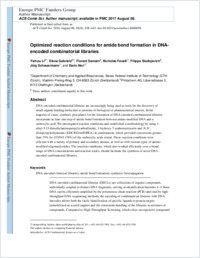Optimized Reaction Conditions for Amide Bond Formation in DNA-Encoded Combinatorial Libraries.
- Li Y Department of Chemistry and Applied Biosciences, Swiss Federal Institute of Technology (ETH Zürich) , Vladimir-Prelog-Weg 3, CH-8093 Zürich, Switzerland.
- Gabriele E Department of Chemistry and Applied Biosciences, Swiss Federal Institute of Technology (ETH Zürich) , Vladimir-Prelog-Weg 3, CH-8093 Zürich, Switzerland.
- Samain F Philochem AG , Libernstrasse 3, 8112 Otelfingen, Switzerland.
- Favalli N Department of Chemistry and Applied Biosciences, Swiss Federal Institute of Technology (ETH Zürich) , Vladimir-Prelog-Weg 3, CH-8093 Zürich, Switzerland.
- Sladojevich F Philochem AG , Libernstrasse 3, 8112 Otelfingen, Switzerland.
- Scheuermann J Department of Chemistry and Applied Biosciences, Swiss Federal Institute of Technology (ETH Zürich) , Vladimir-Prelog-Weg 3, CH-8093 Zürich, Switzerland.
- Neri D Department of Chemistry and Applied Biosciences, Swiss Federal Institute of Technology (ETH Zürich) , Vladimir-Prelog-Weg 3, CH-8093 Zürich, Switzerland.
- 2016-06-18
Published in:
- ACS combinatorial science. - 2016
DNA-encoded chemical libraries
amide bond formation
bioconjugation
synthesis
Amides
Amines
Carboxylic Acids
Combinatorial Chemistry Techniques
DNA
Drug Discovery
Oligonucleotides
Proteins
Small Molecule Libraries
English
DNA-encoded combinatorial libraries are increasingly being used as tools for the discovery of small organic binding molecules to proteins of biological or pharmaceutical interest. In the majority of cases, synthetic procedures for the formation of DNA-encoded combinatorial libraries incorporate at least one step of amide bond formation between amino-modified DNA and a carboxylic acid. We investigated reaction conditions and established a methodology by using 1-ethyl-3-(3-(dimethylamino)propyl)carbodiimide, 1-hydroxy-7-azabenzotriazole and N,N'-diisopropylethylamine (EDC/HOAt/DIPEA) in combination, which provided conversions greater than 75% for 423/543 (78%) of the carboxylic acids tested. These reaction conditions were efficient with a variety of primary and secondary amines, as well as with various types of amino-modified oligonucleotides. The reaction conditions, which also worked efficiently over a broad range of DNA concentrations and reaction scales, should facilitate the synthesis of novel DNA-encoded combinatorial libraries.
- Language
-
- English
- Open access status
- green
- Identifiers
-
- DOI 10.1021/acscombsci.6b00058
- PMID 27314981
- Persistent URL
- https://folia.unifr.ch/global/documents/244320
Statistics
Document views: 27
File downloads:
- fulltext.pdf: 0
